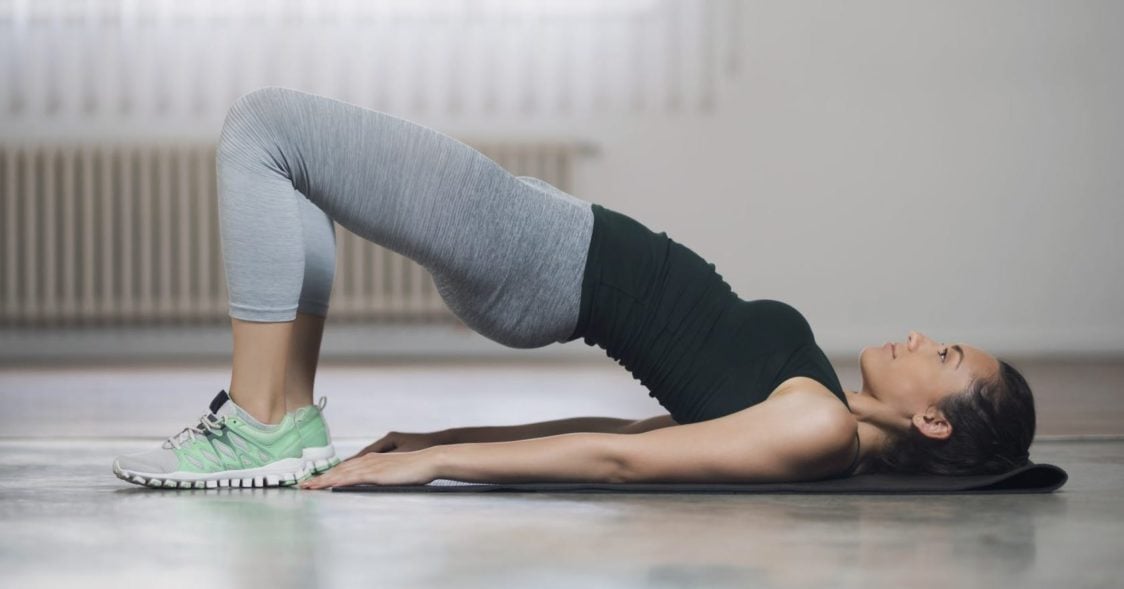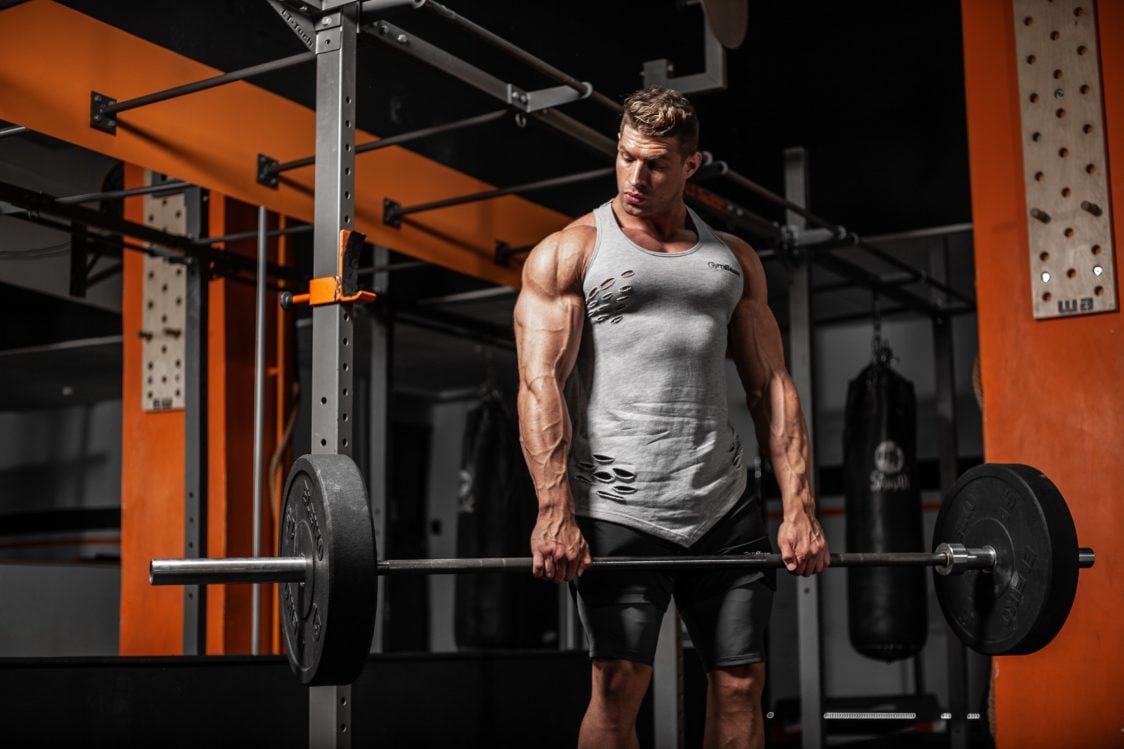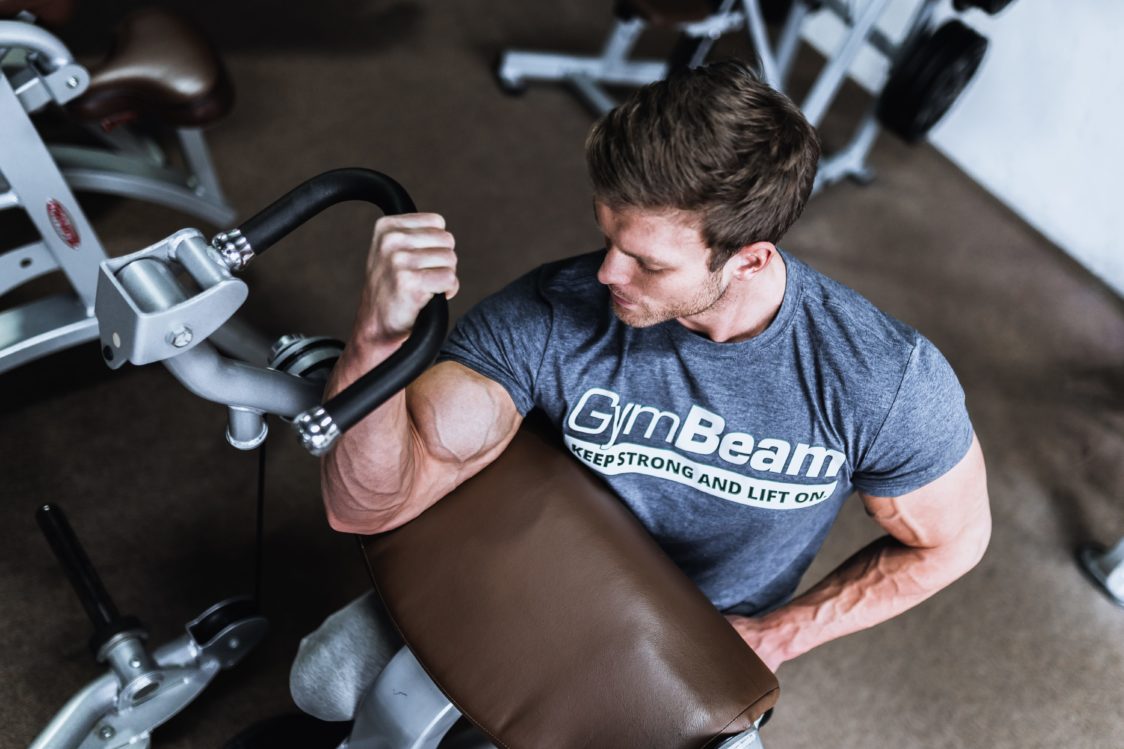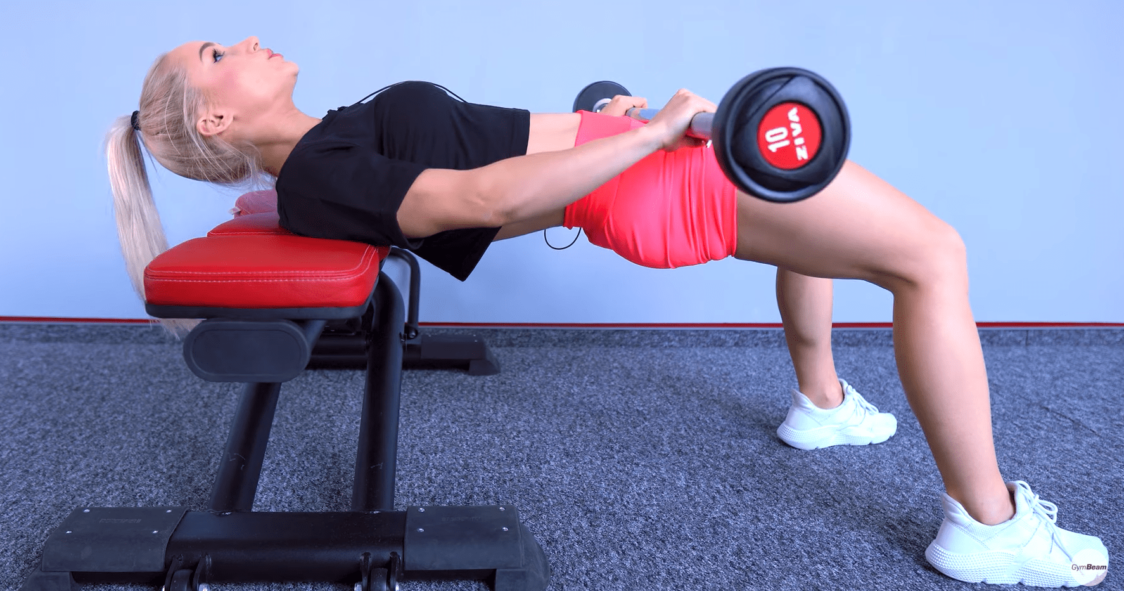Table of Contents
Would you like to pump your butt so that people around you won’t be able to take their eyes off it? So, your workout plan should not miss a unique exercise – hip thrust! By doing it regularly, you will strengthen the sciatic muscles, improve your posture, but most importantly, you will achieve the desired shape!
What is a Hip Thrust
The literal translation of this exercise means “lifting the pelvis”. This is exactly what doing the hip thrust looks like. The basic movement of the exercise is the lifting of the pelvis and the subsequent compression of the sciatic muscles. There are several variations on how to perform this exercise, and you can also make it more difficult by adding weights that you can place on the lumbar region. It is usually a barbell, plate, or other load accessory. [1]
But why should you include hip thrust in your workout plan? It is one of the best and definitely the most popular butt exercises. So, if you want a round and toned butt, you should definitely not miss hip thrust. In addition, this exercise will increase performance and strength in other complex exercises, such as squats or deadlifts, and will also improve the mobility of the whole body. [1]

What muscles do you engage in a hip thrust?
Hip thrust is most often included in the workout plan, mainly to work the butt. Its main benefit is the strengthening and toning of the sciatic muscles. Although squats and deadlifts are considered to be the best butt exercises, the centre of the body, back and thigh muscles are also engaged when performing them. However, with hip thrust, you are guaranteed to make sure that you engage your butt the most. Exercising other muscle parts is a secondary benefit. However, performing hip thrust activates also hamstrings, quadriceps, and adductors. [4] [10]
What is the difference between a hip thrust and a glute bridge?
Many people think that hip thrust is actually just another version of the classic glute bridge. To some extent, they are right. Both exercises are performed by lifting the pelvis towards the ceiling, and then compressing the sciatic muscles. However, the difference between the two exercises is much more complex. So, let’s look at how hip thrust differs from glute bridge. [2]
Glute bridge – performed exclusively on the floor, while hip thrust on a raised backrest. Subsequently, however, the exercise is very similar. [2] For the correct performance of a glute bridge, you should follow this simple procedure:
- lie on your back on the floor
- bend your legs at the knees so that they form a right angle when the pelvis is subsequently raised
- keep your palms on the floor along your body
- squeeze your sciatic muscles – thighs and hips should be in line with your back
- stay in this position for at least 3 seconds
- lower your hips and butt to the floor again and repeat the exercise
- exhale when lifting the pelvis and inhale when placing the pelvis on the ground
A Glute Bridge is most often performed only with your own weight, but you can also add lighter weights to make this exercise more difficult. However, you should pay attention to your back, the higher the load you choose, the more stressed the core of your body and spine will be. This is because a glute bridge can cause a higher overload of the spine than in case of a hip thrust.

Hip Thrust – You will need a bench or other support point for this exercise. The point is to place the shoulder blades on a flat surface that you will lean on and lift the pelvis so that you reach a straight angle between your hips and shoulders. You can use weights in form of barbells, dumbbells, plates or kettlebells to make the exercise more difficult. [2]
For an even better understanding of the difference between a glute bridge and a hip thrust, watch the following video:
The right technique for performing a hip thrust
Performing a hip thrust is not difficult and you do not need any special accessories that you would not find in the gym or could not buy in the sports shop. However, it requires the right technique, without which you would not achieve the desired results. The right hip thrust technique will also protect you from injuries, thus preventing unpleasant back and thigh pains.
What should you do before you start doing a hip thrust?
Before beginning the exercise, you should make sure that you found the right and suitable place. You need a bench or chair to rest your back on during the exercise. The height of your backrest should be approximately 40 cm depending on your height and proportions. The ideal is a bench press bench, which is firmly attached to the floor.
If you are going to exercise with weights, you should choose the right load, which should be adapted to your proportions and physical condition as well. The load should be such that you can lift it with your hips without causing you any pain or injury. You should start with a lighter weight and do more reps. However, placing weights on the hips can be painful and uncomfortable, so consider using a mat or towel. [1]
Correct Hip Thrust Instructions
- Sit with your back facing the bench and lean on the bottom of it with your shoulder blades.
- Place the load on your hips and hold it with your hands – it is best to use the upper arm-width grip.
- Place your feet on the floor.
- The distance between your feet should be slightly wider than the width of the pelvis and hips.
- When lifting the pelvis, the legs below the knees should be at right angles.
- Never tilt your head forward or backward.
- The head and neck should move to the correct position on their own.
- When you are ready, put your heels on the floor and, using your sciatic muscles, lift the weight towards the ceiling so that you reach a straight angle of your head, neck, torso, butt and legs.
- Do not use your back muscles when lifting, otherwise there is a risk of injury.
- In the upper phase of the exercise, squeeze your sciatic muscles, push your hips forward and exhale – stay in this position for at least 3 seconds.
- With an inhale, return to the starting position and repeat the exercise. [1] [3] [10]

You can also watch the correct hip thrust technique in this video:
The most common mistakes when doing a hip thrust
- tilting the head and neck
- exaggerated flexion of the lower back
- lifting on tiptoes
- lifting the weight using the abs or back, not the butt, and pelvis
- insufficient extension in the peak phase of repetition [1] [3]
You might be interested in these products:
Benefits of a hip thrust
It helps strengthen and build sciatic muscles
More and more fitness enthusiasts long for a quality and toned butt, not only from an aesthetic but also a functional point of view. Strong sciatic muscles help to perform other important exercises. One reputable study even found out that hip thrusts activate more muscle fibres in the sciatic muscles than the squats themselves. [5] [6]

It increases strength during a squat and deadlift
It has been proven that if you are just starting out with working out, building sciatic muscles with squats or deadlifts can be more challenging for you than for someone who has been working out for some time. This is because a weaker butt does not create enough pressure on the hips, so activating the lumbar muscles, which coordinate further movements, is more difficult and time consuming. Therefore, a butt that is not toned enough can reduce the depth of the squat, causing subsequent pain, muscle damage, and more intense muscle pain. [8]

It improves posture
The primary function of the sciatic muscles is to move and strengthen the hip joint, which is also responsible for our body’s posture. If you do not work your butt regularly, the muscles on it will weaken and shorten. As a result, for example, when sitting for a long time, you have problems getting up and holding your body upright. [8] [9]
It improves performance and maximizes strength during a workout
Not only strong legs or back, but also a firm butt results in maximizing your performance in the gym. Strong sciatic muscles will help you overcome any obstacles during a workout. By involving them, you can improve stability when performing certain exercises, or even last longer during a run or other cardio workout. The sciatic muscles activate the hip joint, which then coordinates the movements of the legs. [6] [9]

Variations of a hip thrust
There are truly countless ways to perform a hip thrust. Check out some basic variations you will pump your butt with! [7]
Classic Hip Thrust
This is the most basic type of a hip thrust, which we basically already described above. You can use any weight with it. Therefore, this classic type of exercise is further divided based on the type of weight you choose. It is a Hip Thrust with a dumbbell, with a barbell or with a plate.

American Hip Thrust
It is a classic hip thrust exercise, but with one minor improvement. While in the classic version of this exercise you lean on the bench with the lower part of your shoulder blades, in the American version you lean on the bench with a place on your back, which is only under the shoulder blades themselves. With such an “American” position, you put less load on your back and engage the sciatic muscles more.
Please note that in the beginnings it is best to do only the classic hip thrust with light weight load. Over time, you can add heavier weights and liven up your training with specific variations of a hip thrust.
Specific Variations of a Hip Thrust
Hip Thrust with an elevated position of the legs – this is a type of a hip thrust in which you lean your back against a bench and your legs are not placed on the floor, but on an elevated mat
Hip Thrust with one leg – a classic hip thrust, in which you lift one leg stretched together with your butt and hips
Hip Thrust with an expander – a variation of the classic hip thrust, where instead of a barbell you use a resistance band as a load
Tabata Hip Thrust – this is a classic hip thrust, which you perform in the time interval of Tabata (20 to 30 seconds)
Hands free Hip Thrust – classic hip thrust with weights that you do not hold with your hands, but you also must maintain balance which makes this exercise even harder
For more inspiration on different types of a hip thrust, watch this video:
Hip thrust is simply a unique exercise that should definitely not be missing from your workout plan. We emphasize that you should start with lighter weight loads and gradually add heavier weights. However, it is important to fully understand the technique of performing this exercise, which can take some time. If you are unsure, try to contact a trainer in your gym with help.
Do you include a Hip Thrust in your workout plan? Write us in the comments what type of a hip thrust you prefer. If you liked the article, be sure to support it by sharing it among your friends.
[1] Hip Thrust: The most important exercise you´re not doing – https://www.stack.com/a/hip-thrust
[2] Gabrielle Kassel – What’s the Difference Between a Glute Bridge and a Hip Thrust? – https://www.shape.com/fitness/tips/glute-bridge-vs-hip-thrust
[3] Barbell Hip Thrust Video Guide – https://www.muscleandstrength.com/exercises/barbell-hip-thrust
[4] Barbell Hip Thrust – https://journals.lww.com/nsca-scj/fulltext/2011/10000/barbell_hip_thrust.7.aspx
[5] Bret Contreras, Andrew D Vigotsky, Brad J Schoenfeld, Chris Beardsley, John Cronin – A Comparison of Gluteus Maximus, Biceps Femoris, and Vastus Lateralis Electromyographic Activity in the Back Squat and Barbell Hip Thrust Exercises – https://pubmed.ncbi.nlm.nih.gov/26214739/
[6] Jake Boly – Why the Hip Thrust Is a Fantastic Tool for Building Strong and Powerful Glutes – https://barbend.com/hip-thrusts/
[7] Ben Bruno – Up With Hip Thrusts: 7 New Variations – https://www.bodybuilding.com/fun/up-with-hip-thrusts-7-new-variations.html
[8] Roy Pumphrey – 8 amazing things that will happen when you do bridges every day – https://www.lifehack.org/302252/8-amazing-things-that-will-happen-when-you-bridges-every-day
[9] 10 benefits of glute bridge that really do make a difference – https://www.darkironfitness.com/benefits-of-glute-bridges/
[10] Elizabeth Millard CPT – How to Do the Hip Thrust Exercise to Reboot Your Glutes – https://www.openfit.com/hip-thrust

